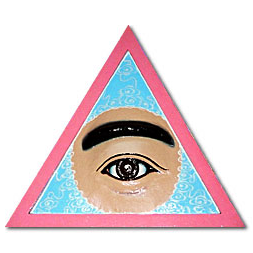
Caodaism is a monotheistic syncretic religion that retains many elements from Vietnamese folk religion such as ancestor worship, as well as "ethical precepts from Confucianism, occult practices from Taoism, theories of karma and rebirth from Buddhism, and a hierarchical organization from Roman Catholicism". It was officially established in the city of Tây Ninh in southern Vietnam in 1926.

Oomoto, also known as Oomoto-kyo, is a religion founded in 1892 by Deguchi Nao (1836–1918), often categorised as a new Japanese religion originated from Shinto. The spiritual leaders of the movement have always been women within the Deguchi family; however, Deguchi Onisaburō (1871–1948) has been considered an important figure in Omoto as a seishi. Since 2001, the movement has been guided by its fifth leader, Kurenai Deguchi.

Inari Ōkami, also called Ō-Inari (大稲荷), is the Japanese kami of foxes, fertility, rice, tea and sake, of agriculture and industry, of general prosperity and worldly success, and one of the principal kami of Shinto. In earlier Japan, Inari was also the patron of swordsmiths and merchants. Represented as male, or female, Inari is sometimes seen as a collective of three or five individual kami. Inari appears to have been worshipped since the founding of a shrine at Inari Mountain in 711 AD, although some scholars believe that worship started in the late 5th century.

Shugendō is a highly syncretic religion, a body of ascetic practices that originated in the Nara Period of Japan having evolved during the 7th century from an amalgamation of beliefs, philosophies, doctrines and ritual systems drawn from local folk-religious practices, Shinto mountain worship and Buddhism. The final purpose of Shugendō is for practitioners to find supernatural power and save themselves and the masses by conducting religious training while treading through steep mountain ranges. Practitioners are called Shugenja or Yamabushi. The mountains where shugenja is practiced are all over Japan, and include various mountains of the Ōmine mountain range such as Mount Hakkyō and Mount Ōmine.

Mokichi Okada. He founded the World Church of Messiah, that later became the Church of World Messianity, and also is the spiritual leader of Shumei and the Johrei Fellowship. He is known by his followers by the honorific title Meshiya-Sama or Meishū-sama. He is the founder of Johrei, an energy healing ritual that uses "divine light" to dissolve the spiritual impurities that are understood to be the source of all physical, emotional, and personal problems.

The Church of World Messianity, abbreviated COWM, is a Japanese new religion founded in 1935 by Mokichi Okada. There are three pillars of the religion, of which the key concept is Johrei, claimed to be a method of channeling divine light into the body of another for the purposes of healing. Other formal practices include The Art of Nature which includes nature farming, and the Art of Beauty which includes practices such as Ikebana, a form of Japanese flower arranging. In 1926, Okada claimed to have received a divine revelation that empowered him to be a channel of God's Healing Light (johrei) to purify the spiritual realm to remove the spiritual causes of illness, poverty, and strife from the world and inaugurate a new Messianic Age. He went on to teach Johrei to his followers to allow them to achieve Messianity and spread the teachings across the world. Members are given permission to channel Johrei by wearing an O-Hikari pendant containing a copy of one of Mokichi Okada's calligraphies. He is often referred to as "Meishu-Sama" by his followers.

Shinbutsu-shūgō, also called Shinbutsu shūShinbutsu-konkō, is the syncretism of Shinto and Buddhism that was Japan's main organized religion up until the Meiji period. Beginning in 1868, the new Meiji government approved a series of laws that separated Japanese native kami worship, on one side, from Buddhism which had assimilated it, on the other.

Omamori are Japanese amulets commonly sold at Shinto shrines and Buddhist temples, dedicated to particular Shinto kami as well as Buddhist figures, and are said to provide various forms of luck and protection.
Mahikari is a Japanese new cult movement (shinshūkyō) that was founded in 1959 by Yoshikazu Okada (1901–1974). The word "Mahikari" means "True Light " in Japanese.
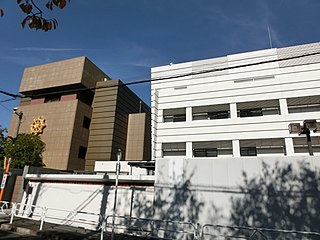
Shinnyo-en is a Japanese Buddhist new religious movement in the tradition of the Daigo branch of Shingon Buddhism. It was founded in 1936 by Shinjō Itō, and his wife Tomoji in a suburb of metropolitan Tokyo, the city of Tachikawa, where its headquarters is still located.
Harae or harai is the general term for ritual purification in Shinto. Harae is one of four essential elements involved in a Shinto ceremony. The purpose is the purification of pollution or sins and uncleanness. These concepts include bad luck and disease as well as guilt in the English sense.
An Inari shrine is a type of Japanese shrine used to worship the kami Inari. Inari is a popular deity associated with foxes, rice, household wellbeing, business prosperity, and general prosperity. Inari shrines are typically constructed of white stucco walls with red-lacquered woodwork, and their entrances are marked by vermilion torii. Both Buddhist and Shinto Inari shrines are located throughout Japan.

Hikaru Museum is a museum in Takayama, Gifu Prefecture, Japan, comprising exhibition rooms for fine arts, archaeological research, and history, including exhibitions of artifacts excavated from civilizations across the world and displays of the history of the old Hida Province of Japan.
Yoshikazu Okada, born February 27, 1901, in the Aoyama area of Tokyo's Minato Ward, also known as Kōtama Okada, was the founder of a new religious movement in Japan (Shinshūkyō) generally referred to as Mahikari.
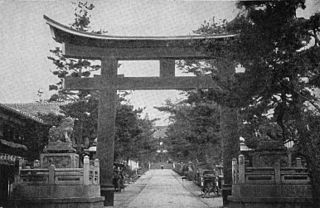
Shinto, the folk religion of Japan, developed a diversity of schools and sects, outbranching from the original Ko-Shintō since Buddhism was introduced into Japan in the sixth century.
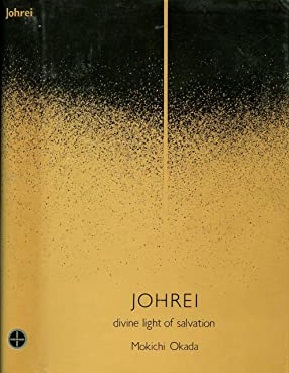
Johrei "purification of the spirit", spelled jyorei by Shumei groups, is a type of energy healing, It that was introduced in Japan in the 1930s by Mokichi Okada,.
Shinji Shūmeikai (神慈秀明会) is a Japanese new religious movement and organization founded in 1970 by Mihoko Koyama. Prior to founding the organization, she was president of the Shumei Church, the largest internal association of the Sekai Kyūseikyō, and founded the organization as a spin-off of the Church of World Messianity. The purpose of the organization was to promote the health, happiness and harmony of all people by applying the insights of Mokichi Okada, the founder of Church of World Messianity. According to the organization, the founder is not Mihoko Koyama, but Mokichi Okada.

The New Castle of Ansembourg, in central Luxembourg is one of the castles belonging to the Valley of the Seven Castles. Located about one kilometre or just over half a mile below the Old Castle of Ansembourg, it was built by the industrialist Thomas Bidart in 1639.

Multiple religious belonging, also known as double belonging, refers to the idea that individuals can belong to more than one religious tradition. While this is often seen as a common reality in regions such as Asia with its many non-exclusionary religions, religious scholars have begun to discuss multiple religion belonging with respect to religious traditions such as Judaism, Christianity, and Islam.
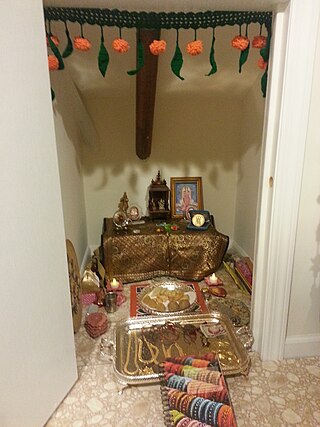
The Conservation of South Asian household shrines is an activity dedicated to the preservation of household shrines from South Asia. When applied to cultural heritage, held by either museums or private collectors, this activity is generally undertaken by a conservator-restorer. South Asian shrines held in museum collections around the world are principally shrines relate to Hindu, Jain, or Buddhist households. Due to their original use and sacred nature, these shrines present unique conservation and restoration challenges for those tasked with their care.














